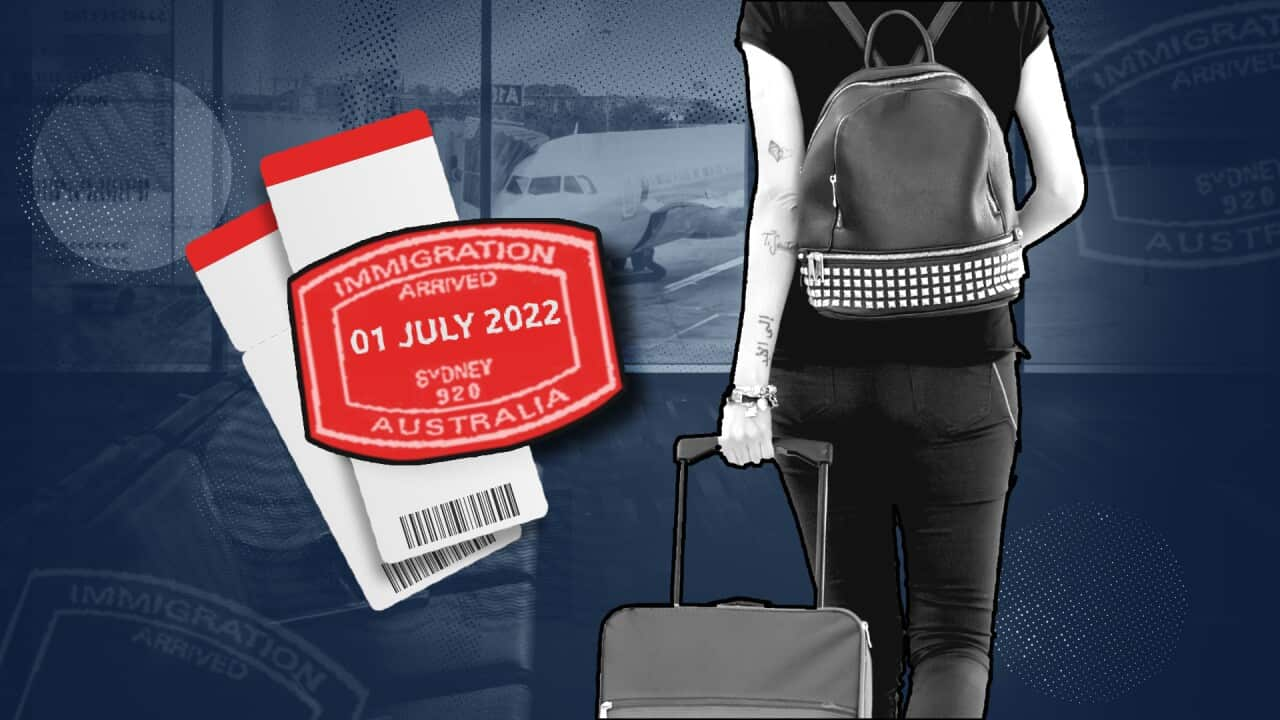Key Points
- Changes will benefit a range of visa holders
- Pathways for skilled workers to enter Australia about to rise by more than 30,000 places
Visa changes from 1 July will offer skilled workers new pathways to permanent residency, more places for working holiday makers and the chance for graduates impacted by COVID-19 border closures to make up for their time locked out of Australia.
Ben Watt, a lawyer with migration agents VisaEnvoy, said the changes presented “exciting” prospects for some, with a focus on supporting the economic recovery from COVID-19.
“It is very difficult for a lot of people and a lot of industries to fill staff shortages, especially in certain skilled fields,” he said.
“What this is doing is pumping as many people into the system as possible."
Mr Watt also said the 1 July changes were being viewed as a reward to certain visa holders that toughed it out and remained in Australia during the pandemic.
“There were a lot of difficulties for people who were here on temporary visas during COVID because there was a lot of uncertainty.
“A lot of people lost their jobs or got stood down, they weren’t able to access welfare.
"There were all sorts of difficult things that the cohort of temporary visa holders encountered."
Here are some of the key changes:
Temporary skill shortage visas
Temporary skill shortage (TSS) subclass 482 visa holders will find it easier to apply for permanent residency.
In Australia, as of 31 March, there were 52,440 people on the 482 visas, or related 457 visas, which ceased offering new places to applicants in March 2018.
From 1 July, those visa holders can apply for the Temporary Residence Transition (TRT) visa, which lets skilled workers who are nominated by their employer to live and work in Australia permanently.
But the new pathway will only be accessible for two years from this date.
Luke Edwards, associate lawyer at Work Visa Lawyers, said the temporary change would now make living in Australia permanently more accessible for these visa holders.
“A lot of them [visa holders] were staring down a hard and not very guaranteed pathway to permanent residency,” Mr Edwards said.
“Clients and people I’ve heard from are very excited to now have the opportunity…to stay in Australia.”
Those eligible would need to have been in Australia for at least one year between 1 February 2020 and 14 December 2021.
The change will also apply to subclass 457 visa holders with an occupation on the Short-term Skilled Occupation List (STSOL).
A Department of Home Affairs spokesperson told SBS News the “special concession” recognised “those highly skilled migrants who chose to stay in Australia throughout the pandemic.”
“This allows them to stay here, with a pathway to stay here, with a pathway to Australian citizenship,” the spokesperson said.
Age limit exemption
Another change impacting 457 visa holders means they will no longer be restricted by age from applying for permanent residency through the TRT stream.
Mr Edwards said these visa holders aged 45 and over previously had limited to no pathways to pursue permanent residency.
“There are some people who have been working in Australia for a very long time now, sponsored by their employers,” he said.
“They weren't able to achieve permanent residency while they were younger [and] are now aged out of the system. This change is something they’d hope for a long time.”
The change - which now specifies no age limit to pursuing this option - will also only be accessible for two years from 1 July.
To be eligible for the age exemption change, 457 visa holders need to have held the visa from or after 18 April 2017.
They’ll also need to have been in Australia between 1 February 2020 and 14 December 2021 for at least one year.
Temporary graduate visas
Also from 1 July, current and former temporary graduate visa holders who lost time due to COVID-19 travel restrictions can also apply for a replacement visa.
To be eligible, people must hold a valid temporary graduate visa, or have previously held a temporary graduate visa that expired on or after 1 February, 2020.
They’ll also have to have been outside of Australia between 1 February 2020 and 15 December 2021.
The measure was announced expecting that it will benefit approximately 30,000 current or former Temporary Graduate visa holders.
Mr Watt said because of the education experience of these graduates, they had the potential to quickly offer a positive contribution to the workforce.
“We’ve got a big cohort of people with really great skills, with really great Australian education, that never had a chance to stay on and spend the time on their graduate visa here."
A spokesperson for the Department of Home Affairs said: “this replacement stream remedies the situation for those who missed out on their TGV stay period due to COVID-19.”
Typically, applicants are limited to just one initial subclass 485 visa, and a further visa is only available on the basis of regional work and study.
Working holiday maker visas
The COVID-19 border closure meant working holiday makers were locked out of the country, placing strain on industries normally reliant on their contribution.
But from 1 July, there will be a 30 per cent cap increase, over 2022-23 only, to the number of places available to working holiday makers from several countries, which face a cap, as part of the subclass 462 visa arrangement.
From the new financial year, Mongolia and Brazil will also have access to Australia’s Working Holiday Maker visa program, and there will also be changes to age limits and caps for some countries.

The National Farmers Federation has called on the new Labor government to help improve worker availability to address the chronic labour shortages crippling the farming sector. Source: AAP / LUKAS COCH
There will also be a cap increase for Work and Holiday visa arrangements for Hungary, Austria and the Slovak Republic totalling 1,400 places.
Mr Edwards said some sectors were “desperately in need” of the contribution made by working holiday makers to addressing labour shortages.
“There’s a big call from especially regional Australia and farm businesses for more workers and more seasonal workers like the work holiday visa provides,” he said.
What will be the new government’s approach?
1 July also marks the resetting of places in the migration program, presenting new opportunities for migrants.
The various pathways for skilled workers to enter Australia are about to rise by more than 30,000 places.
to push for a renewed focus on permanent residency pathways, to combat insecurity posed by rising levels of temporary migration.
But the new government, elected in May, has inherited a migration program still grappling with the impacts of the pandemic, and has
Decisions made by its predecessors regarding the visa framework will continue, with some having real implications for those impacted.
Mr Watt said people shouldn’t expect “enormous change” to the visa system immediately because of a change in government.
“There will need to be a number of years or at least twelve months before we are going to see any big change in direction or change."
Official information about visas and immigration can be found at Australia's .














